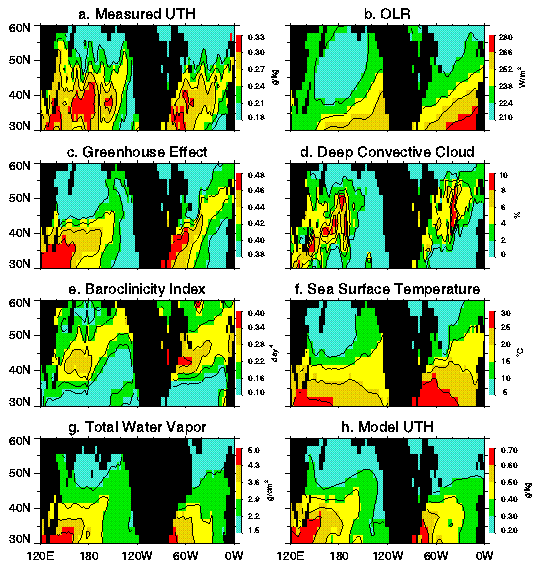 EXTRATROPICAL INFLUENCE OF UPPER TROPOSPHERIC WATER VAPOR ON GREENHOUSE WARMING
EXTRATROPICAL INFLUENCE OF UPPER TROPOSPHERIC WATER VAPOR ON GREENHOUSE WARMING

The figure shows that the increase in upper tropospheric humidity (a)
is collocated with a decrease in outgoing longwave radiation (b)
and an increase in greenhouse warming (c) along the strom track in
the North Pacific and Atlantic; a clear demonstration of the role
of upper tropospheric humidity in trapping radiation. The mechanism of enhenced
upper tropospheric humidity over the storm track seems to be associated
with the increased deep convective cloud (d) which transports water
vapor upward to the tropopause. The generation of these deep convective
clouds are associated with large-scale baroclinic waves along the storm tracks;
The Eady growth rate is a measure of baroclinic instability (e).
The distribution of integrated water vapor (f) closely follow sea
surface temperature (g) and is more less zonally oriented. Therefore,
the upper tropospheric water vapor is likely to be governed by the
large-scale dynamics and not the local temperature, in contrary to
some popular postulations.The pattern of upper tropospheric humidity provided by
the GSFC Data Assimilation Office does not resemble the observations (h).
It agrees more with the surface temperature distribution, and may imply the
deficience in model simulation of upper atmosphere hydrologic balance.
The upper tropospheric humidity is measured by the Microwave Limb sounder
on UARS. The deep convective cloud amount is provided the
Interanational Satellite Cloud Climatology Project, the sea surface
temperature is from AVHRR, the outgoing longwave radiation is from the Earth
Radiation Budget Experiment, the integrated water vapor is from Special
Sensor Microwave Imager, the Eady growth rate is computed using output from atmospheric
general circulation model.
More details can be found in the article by Hu, H., and W.T. Liu, 1998: The impact of upper troposheric humidity from
Microwave Limb Sounder on the midlatitude greenhouse effect. Geophys. Res.
Lett., 25, 3151-3154

